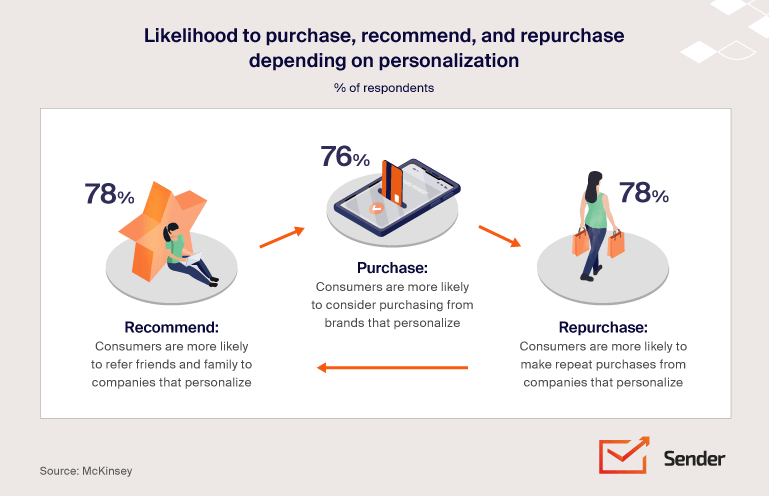Everyone’s sending marketing emails – you probably already have an email campaign marketing strategy on the books. But do you know how to keep your emails out of the spam folder?
That’s where email deliverability comes in. The effectiveness of email marketing depends on email deliverability, and it’s something that you may take for granted.
What is Email Deliverability?
The phrase “email deliverability” sounds complicated, but it’s actually something everyone with an email address interacts with every day. Email deliverability refers to how successfully an email reaches its intended recipient’s inbox, as opposed to being sent to the dreaded spam folder.
Email deliverability is influenced by various factors ranging from the sender’s reputation to the complexities of email service providers’ (ESPs) algorithms. We’ll go over all of this at length, so don’t worry if it sounds like a lot!
Good email deliverability means your inbox placement rate is high, setting the foundation for email message engagement. On the other hand, poor email deliverability means messages still end up in the spam folder, even if you have the most meticulously crafted email campaign.
As such, understanding and optimizing email deliverability is important for any business that uses email marketing as a part of its digital strategy. So, let’s get started!
Why Does Email Deliverability Matter?
Email deliverability can affect email marketing campaigns in several ways:
- Reach and engagement: Did you know that 70% of marketers around the globe consider email campaigns to be effective? High email deliverability means more emails reach inboxes, leading to better engagement rates. These rates are crucial for nurturing leads and building relationships, which boosts conversions.
- Brand reputation and trust: Consistently landing in the inbox builds trust with your audience and creates customer connection. Along with that, it shows that internet service providers recognize your brand as legitimate – and valuable! This makes email deliverability an important piece of your overall SEO strategy.
- Return on investment: Improved email deliverability leads to higher open and click-through rates. Boosting these rates gives you a higher return on investment, which is always the goal of any marketing campaign.
To break it down: Email deliverability ensures that your messages actually reach your audience, allowing you to communicate, engage, and convert.
Good email deliverability rates mean that your marketing efforts reach your intended audience, which maximizes the return on investment of email campaigns. All of these things work together to grow your business.
Sender makes sure your email campaigns reach the recipients’ inboxes. And it has all the features your business needs in one simple dashboard.

How Does a Good Email Deliverability Rate Look?
Good email deliverability is typically defined as having 95% or more of your emails successfully reach the recipient’s inbox. Along with that, you want to make sure your bounce rate isn’t higher than 3%.
A high level of email deliverability is a clear sign of effective email campaigns, which gets the ball in motion for email marketing success.
What Affects Email Deliverability?
Two of the biggest factors affecting email deliverability are email campaign content and sender reputation. Here’s the breakdown of why they matter:
Keeping track of your email campaigns and making sure you aren’t using phrasing in your subject line or email to trigger spam filters is the first step to email deliverability success. Also, be sure to use a reputable email client, especially if you have a large mailing list.
Email sender reputation is the most important driving force of email deliverability, as it shows service providers that your emails are legitimate. Deleting inactive subscribers from your list and maintaining your domain reputation will go a long way.
Avoiding spam traps isn’t difficult, as long as you perform regular maintenance and choose your subject lines carefully.
Email deliverability isn’t the only factor you should be aware of. Check out 13 common email marketing mistakes and how to avoid them.
What is an Email Bounce?
Ever sent an email only to have it bounce back to you like a boomerang? That’s an email bounce! This happens when your email can’t be delivered to an inbox and gets “bounced” back to you, usually with a failure notice that looks like this:

Below, we’ll discuss two kinds of email bounces — soft and hard. While there isn’t much you can do about an email that’s bounced back to you, you can take steps to prevent bounces from happening. Taking those steps will do wonders for your email deliverability.
What is a Soft Bounce?
A soft bounce is a temporary email delivery problem, so it’s definitely the lesser of the two email bounce evils. Soft bounces may happen because of problems with the email server, which may be fixed in a matter of minutes. This is why it’s always good to try your message again a bit later after a bounce notice, just to be sure the problem hasn’t resolved itself.
Sometimes, soft bounces happen because your recipient’s inbox is full. This doesn’t happen very often nowadays, but if your subscriber has hit their inbox maximum, you may want to take them off your list as they’re almost certainly inactive. If the next few email campaigns bounce from their address, you’ll know it’s time to weed them out.
One more reason that you may be getting soft bounces is the email message you’re trying to send is too big. Don’t worry as much about this unless you notice a handful of soft bounces at once, especially if you’re using an email program that warns you about your content. In this case, you’ll want to trim down your message content or consider sending a plain text version of it.
What is a Hard Bounce?
Unlike a soft email bounce, a hard bounce is when your email messages are permanently unable to reach the inbox. While this sounds a lot more frustrating, the solutions are more clear-cut than a soft bounce.
A hard bounce could be a product of human error like a typo, or perhaps the recipient switched email service providers but wrote in the old provider instead (Gmail vs Yahoo, for instance). These reasons are the most common for a hard email bounce – typos happen, memories slip, we’re only human, after all!
Even when it’s a human error issue, you’ll still want to remove the offending email address from your mailing list. If it’s a repeat customer you know well or someone you’re in contact with, consider bringing it up in a conversation, you’re already having with them, especially if they reach out with a different email address.
Consider how you store email addresses so they can be easily updated by people on your list. This will minimize email service switchover issues and ensure your emails hit your subscribers’ inboxes.
Hard bounces may also be a product of fake email addresses on your list or users who have blocked you. Unfortunately, there isn’t anything that can be done to address this besides removing the problem email addresses and validating your list from time to time. Use email validation tools to ensure the addresses are current and valid and enhance overall deliverability.
How to Test Email Deliverability?
Testing email deliverability is easy as pie. Send yourself an email from your business account, then see if your message hits your personal inbox on the first try. If you receive messages from your business, you likely have nothing to worry about.
If your email gets caught in your spam trap, make sure the sender address is clear and check for spam trigger phrases. Also, make sure to test the reputation of your business’s dedicated IP addresses and make improvements where needed.
While you’re at it, take a look at your overall email strategy. In 2024, leveraging advanced technologies like AI tools will become increasingly important. AI can suggest the best time to send an email, personalize content at scale, and optimize the subject line for higher open rates.
Check out our other tips below for avoiding the spam section of the inbox to pinpoint and resolve any spam issues.
Tips to Avoid the Spam Section of the Inbox
Now that you know what email deliverability is all about, you’re likely asking what you can do to have a good rate. Here are some email deliverability best practices to keep your messages out of the spam folder.
Incorporate New Google Spam Policies
Google has begun cracking down on spam emails, with new policies that started in February 2024. In addition to keeping track of your sender score, you’ll want to make sure that you’re taking email security seriously and set up SPF or DKIM verification, which we’ll talk about later.
The most important aspect of this update is that you’ll need to have a spam rate that’s less than 0.3%. So, do what you can to ensure that you keep spam complaints to a bare minimum. Google’s policies for businesses sending 5,000 emails a day also include making unsubscribing easy, which will help with this.
If you send over 5,000 emails a day, you’ll also want to make sure you set up DMARC authentication.
As of 2023, Gmail is the second most popular email service provider, so not following these new policies could affect email deliverability to a big portion of your mailing list. Along with this, since Google is unparalleled in industry leadership, you can likely expect other email providers to follow suit with these policies.
Sender Reputation
Sender reputation is how trustworthy internet and email service providers think your business is, and it’s influenced by a few moving parts. Sending habits, engagement from your mailing list, and the reputation of your specific IP addresses and domains all play a role in your sender reputation.
Signs of positive engagement include high open and click-through rates as well as low unsubscribe or spam complaint rates. Positive engagement means that you have good content, which boosts your sender reputation and email deliverability rate. Engaging formats like video content will boost your open and click-through rates.
Domain reputation goes hand in hand with sender reputation. A positive domain reputation is a good safeguard against a mailbox provider marking your emails as spam messages.
Like domain reputation, your IP address reputation plays a role in your sender reputation. A dedicated IP address for your business will boost your email delivery game
Your email deliverability rate will increase when internet service providers (ISPs) read your business as legitimate. So, all of these factors are important, even if it’s a lot to keep track of at once.
Email Filters
In addition to making sure your sender reputation is all set, you’ll also want to regularly go over your email list and filter out unknown users. Inactive subscribers can ding your sender reputation, which as you know, can affect your email deliverability rate.
As stated, Google is building easy unsubscription into its spam prevention policies, but it’s good practice anyway. Make sure there’s a clear unsubscribe link attached to each email you send.
It may seem strange to build unsubscription into your email strategy. But a healthy mailing list packed with active subscribers who engage with your emails paves the way for a solid deliverability rate. Plus, it may save you a bit of time from having to remove long-inactive subscribers yourself.
Email Personalization
Personalization in email marketing goes beyond addressing recipients by their names. It involves creating relevant content that suits your audience’s preferences, past interactions, and interests.
You can create relevant and personalized messages using purchase history, browsing behavior, and engagement patterns. High levels of email personalization makes each recipient feel valued and understood, which means they’ll be more likely to open your emails and make a purchase. After all, that’s what the endgame goal is, right?
When combined with segmentation, personalization becomes even more powerful. Dividing your email list into segments or smaller groups based on shared characteristics or behaviors allows for even more precise messaging. You can get this information from lead generation forms on your site, purchase history records, or localize your content based on region.
By using this approach, you’ll ensure that your emails are seen and meaningful to each recipient. When your emails are meaningful, it will boost engagement rates and skyrocket the revenue of your email campaigns.

Avoid Spam Folder Trigger Phrases
We all know spam trigger phrases – they usually lean on urgency and say things like “Buy today!” or “Take action!”. Most email marketers already know to avoid them, but just in case you need a refresher, keep your subject lines calm and personable. Meeting your audience where they’re at instead of being pushy will go a long way.
At the end of the day, as long as you’re engaging in email marketing in a legitimate way, you don’t have to worry as much about the dreaded spam folder. Just be sure to only send marketing emails to people who have signed up for them, keep an eye on your sender’s reputation, and keep Google’s new policies in mind – then, you’ll be good to go.
Email Deliverability FAQ
If you still have questions, don’t worry. We’ve covered the most popular email deliverability questions below.
What are SPF and DKIM?
To understand SPF and DKIM, we have to back up a little to the email flow process.
A crucial aspect of ensuring email deliverability is domain-based message authentication, which is what SPF and DKIM are. They act like a verification system, confirming to an internet service provider that an email is genuinely from the sender it claims to be.
SPF, or Sender Policy Framework, is email’s first line of defense. It enables the domain sending the email to specify which email servers and IP addresses are permitted to send emails on its behalf.
If an incoming email originates from an IP address not recognized on this list, SPF flags it. This ensures that only an authorized mail server (or the sender’s IP address) can deliver emails to subscribers’ inboxes. In turn, this keeps your subscribers safe.
Another verification technique is DomainKeys Identified Mail, or DKIM, which adds an extra layer of trust to your emails, akin to sealing them with a unique digital signature. This signature is verified against a key associated with the sender’s domain. Matching these keys ensures the email hasn’t been altered en route to its destination, maintaining your email’s integrity.
Why do emails sometimes end up in the spam folder?
Spam filters were made to catch email spoofing and other fraudulent, scammy activity, but there are reasons why perfectly legitimate emails end up in spam. Poor sender reputation, spam trigger words in your subject line or copy, and not using appropriate email clients can keep your email from hitting the inbox.
Take precautions and improve your email deliverability by keeping an eye on your sender score and vetting your email programs, especially if you’re automating. While it’s true that a bad workman always blames their tools, sometimes the tools just aren’t right for the job you need them for.
For the most part, if you run a small business and use a reputable email marketing program, you don’t have much to worry about.
What is double opt-in?
There are two ways to collect email addresses: single-opt in and double-opt in. Ideally, you’ll want to use a double opt-in method, which is when someone signs up with their email address on your website. Then, they verify their place on your mailing list via a confirmation link.
The single opt-in method only requires email addresses from audience members, so they may not know what they’re signing up for.
Conclusion
Maintaining good email deliverability is essential for successful email marketing, but it’s not just about avoiding the spam filter.
- Email deliverability is about making sure your messages reach the right inboxes, engage your audience, and ultimately help you hit your desired results;
- Every aspect of your email strategy contributes to this goal, from personalizing content to using the right tools;
- With a focus on optimizing deliverability and providing valuable insights, Sender is an excellent solution for anyone looking to enhance their email strategy.
Keep on learning — check out these valuable articles on email marketing:
Author bio
Cass is the Head of SEO Outreach and Link-Building at Omniscient Digital, an organic growth agency that helps marketing leaders at B2B software companies turn SEO and content into growth channels. She loves writing about SEO, email outreach, content operations, ecommerce, and social media marketing.
